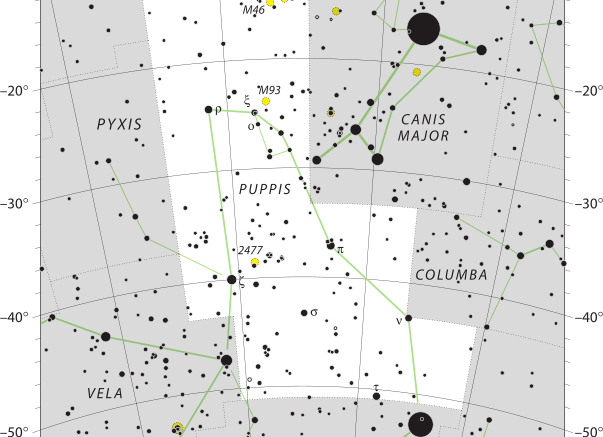Located in the southern sky, the constellation Puppis was originally part of the larger constellation Argo Navis. Argo Navis was broken into 3 parts, with Puppis being the largest constellation in square degrees. It is one of the 88 modern constellations recognized by the International Astronomical Union.
Puppis is the 20th constellation in size, occupying an area of 673 square degrees, and belongs to the Heavenly Waters family of constellations. Neither
| Applicable Information | |
| Visibility In Pacific Northwest | November to March |
| Best Times To View | February |
| Right Ascension | 7.5h |
| Declination | −30° |
| Area | 673 square degrees |
| Main Stars | 9 |
| Brightest Object | ζ Pup |
| Meteor showers | Pi Puppids, Zeta Puppids, and Puppid-Velids |
| Messier objects | 3 |
| Neighboring Constellations | Monoceros, Pyxis, Vela, Carina, Pictor, Columba, Canis Major, Hydra |
Cool Facts
- The constellation of Puppis was once part of the gigantic Argo Navis constellation, which was later split into three smaller constellations, namely Puppis, Carina, and Vela.
- Argo Navis was first catalogued by the Greek astronomer Claudius Ptolemy in his Almagest in the 2nd century CE.
- Puppis is the largest of the 3 constellations that resulted from the breaking up of the larger Argo Navis constellation.
- Puppis nor Vela have stars designated Alpha and Beta, as these stars were allocated to Carina constellation.
Stars
Puppis contains five named stars, which are Azmidi, Naos, Nosaxa, Tislit, and Tureis.
Argo Navis was sub-divided into three sections in 1752 by the French astronomer Nicolas Louis de Lacaille, who kept a single set of Bayer designations for the whole constellation Argo.
There have been 4 extrasolar planetary systems found in the constellation.
As the Milky Way runs through Puppis, there are many open clusters in the constellation. M46 and M47 are two open clusters in the same binocular field. M47 can be seen with the naked eye under dark skies, and its brightest stars are 6th magnitude. Messier 93 (M93) is another open cluster somewhat to the south. NGC 2451 is a very bright open cluster containing the star c Puppis, and the near NGC 2477 is a good target for small telescopes. The star Pi Puppis is the main component of a bright group of stars known as Collinder 135.
M46 is a circular open cluster with an overall magnitude of 6.1 at a distance of approximately 5400 light-years from Earth. The planetary nebula NGC 2438 is superimposed; it is approximately 2900 light-years from Earth. M46 is classified as a Shapley class f and a Trumpler class III 2 m cluster. This means that it is a rich cluster that appears distinct from the star field. However, it is not at its center. The cluster’s stars, numbering between 50 and 100, have a moderate range in brightness.[3]
Make sure to check out other articles on the site, including a brief introduction to constellations, other constellation articles, and more!

Be the first to comment on "Puppis"